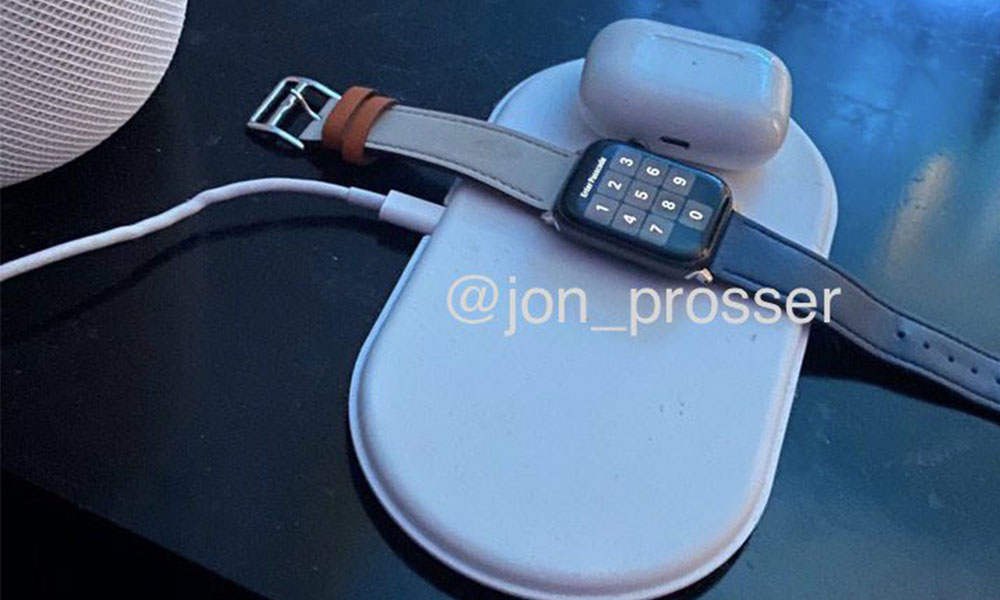We Could See Apple’s ‘New AirPower’ Charging Mat This Fall as More Prototypes Are Revealed
 Credit: Jon Prosser
Credit: Jon Prosser
Toggle Dark Mode
More evidence has surfaced suggesting that Apple hasn’t entirely given up on its AirPower charging mat, with new leaks offering photos of the redesigned mat in action and suggesting that Apple may finally be working out some of the bugs that foiled Apple’s original plans.
Back in April we heard that Apple was testing a new AirPower prototype that would feature an A11 chip — a much more ambitious design than the original AirPower, considering that the A11 chip powered Apple’s iPhone X.
According to the rumour at the time, the device was codenamed C68, and while there were still some problems to be worked out, Apple had reportedly begun issuing prototype units to engineers to actually take home and test, suggesting that the company has already made it farther along with the new AirPower than it did with its first attempt.
‘They got the Watch working’
Now leaker Jon Prosser, who shared the original information back in April, has returned with an update showing that Apple is continuing to forge ahead with the project, and offering a few photos of what he alleges is the C68 prototype in action, complete with an Apple Watch charging on the pad.
As Prosser notes, the main problem Apple was struggling with back in April was allowing the mat to charge the Apple Watch without creating the kind of excessive heating problems that likely caused the original AirPower to be cancelled.
According to the information that Prosser shared at the time, the proprietary charging method used by the Apple Watch required more energy to charge, which would cause the entire mat to overheat, “and in most cases, combust.” Prosser claims that Apple’s move to the A11 architecture has helped to regulate the heat by monitoring the unit’s temperature, and temporary suspending charging when coil temperatures rise beyond a safe level.
The A11 Chip
It’s unclear why Apple would need something as powerful as an A11 chip simply to regulate charging and heat — it sounds like massive overkill to us, considering that temperature and power regulation chips have been around for years without needing the horsepower an iPhone X class SoC behind them, even with Prosser’s suggestion of dynamically routing power to different coil regions according to temperature levels.
Of course, the A11 in this new prototype will likely do quite a bit more than just providing thermal and power management, including managing communication with other devices that are placed on the mat. The new AirPower could even go well beyond this into offering things like HomeKit compatibility, and it will likely run some kind of embedded derivative of iOS.
In short, the A11 is a ridiculously powerful chip to be used simply to keep the AirPower from overheating, however Prosser isn’t an engineer and he’s probably just relaying an oversimplified version of whatever information he’s been able to glean from his sources.
Charging Coils and Overheating
Similarly, Prosser’s claims that the Apple Watch needs “more energy to charge” aren’t accurate either, as the standard Apple Watch charger operates at only around 0.2A — a mere fraction of the 1.5A that an iPhone is capable of drawing from a wireless charger.
That said, however, the actual charging coils on an Apple Watch charger are significantly closer together, which is why the Apple Watch can’t charge from most Qi-enabled wireless chargers; it’s not that the Apple Watch charging system is proprietary per se, but rather than the coils simply aren’t small enough on most chargers to line up with the Apple Watch.
While the standalone Apple Watch charger obviously doesn’t generate any significant amount of heat, Apple’s intention for the AirPower has always been to let users set their devices down anywhere to charge without having to worry about exact placement. This means that to support the Apple Watch, the mat would need to have the same extremely dense coil layout throughout that’s normally found on the small one-inch Apple Watch charging disk. This would definitely generate more heat.
The original AirPower charging mat was one of Apple’s rare public missteps, with the product first announced alongside the iPhone X in the fall of 2017 with expected availability by the following year. However, after 2018 came and went with no sign of the new charging mat, Apple finally admitted that it just wasn’t going to be able to pull it off, stating only that it failed to meet its high standards without going into any further details. However, several reliable sources revealed that overheating was the primary issue that killed the original charging mat, which makes perfect sense based on what we knew of Apple’s rather ambitious multi-coiled design.
It’s good to see that Apple hasn’t entirely abandoned the idea, however, although this time around the company isn’t going to make the mistake of announcing it before its fully convinced that its engineers will be able to figure it out. The fact that prototypes are being used in engineers’ homes suggests that the devices are already much safer than before, although it seems Apple still has a few things to work out, both on the power and thermal engineering side as well as on interdevice communications. According to Prosser, however, if everything goes according to plan, we could see the new AirPower mat make its appearance as soon as this fall.
[The information provided in this article has NOT been confirmed by Apple and may be speculation. Provided details may not be factual. Take all rumors, tech or otherwise, with a grain of salt.]






